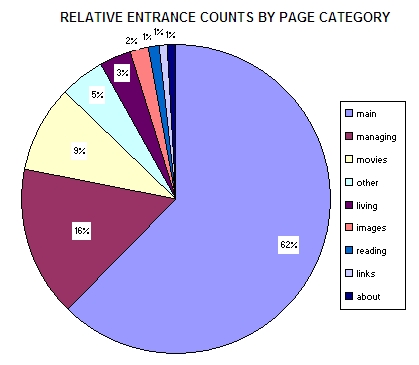A couple of weeks ago I signed up for the free Google Analytics service. This free Google service tracks web site usage including frequency, type, and source of visits, as well as behavior of visitors after they come to a site’s initial web page. I figured that, if Google was going to be knowing everything about my site in order to help it calculate advertising rates, I should at least take advantage of the data.
The variety of statistic available from Google is almost bewildering. Many are more appropriate to commercial web sites where money changes hands. My site is a self-supported promotional site where I write about professional and personal interests, but I decided to start looking at the statistics anyway.
I’m glad I did. I already know from my web publishing service provider (Squarespace) that links from other web pages and from RSS and Atom feeds are more important (numerically) than search engine queries in generating raw site traffic.
Poring through the Google Analytics data this was also very clear. What I saw was the overwhelming importance of my main page (called “Recent Postings” here) as being the initial touch point for the vast majority of my visitors. Based on this I decided to beef up the ability of this main page to “capture” and link visitors to “inside” pages in order to reduce the number of visitors who “bounced” after visiting only one page. That’s why I’ve peppered my initial page with so many internal links. Using Google Analytics I’ll now be able to track how many people visit just one page, and for those who stay around, where they go in my site from each initial page visited.
The graphic below shows the relative sizes of the different page groups in terms of incoming visits:

The majority of “entrances” to All Kind Food come in through the main page which I call “recent postings.” This is followed by pages in the “managing technology” section, then by various “movie reviews.”
This latter fact surprised me somewhat. I had not expected so many hits on the movie reviews relative to the technology related sections. Looking through the data more closely, I see (but I’ll have to test this hypothesis) that it appears that the main page and the “managing technology” pages seem to be more likely to be visited by people coming in via direct links, while my movie reviews are more likely to be hit by those referred via a search engine.
So, that’s my first attempt at using Google Analytics to tell me something about the behavior of visitors to my modest web site. I still have much to learn, but I’m already picking up some useful tips on how to look at the statistics generated by Google and by my provider Squarespace.
The data, for example, are shedding some light on a topic that has plagued me from the beginning, which is how to balance the variety of interests reflected in the web site, and whether or not I should break the site up into different parts. That may still happen, but for now, I’m going to look a lot deeper into these numbers.
____________________________________________
Entries in this series:
- Learning to Use Google Analytics
- Learning to Use Google Analytics, Part 2
- Learning to Use Google Analytics, Part 3
- Learning to Use Google Analytics, Part 4